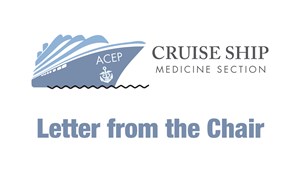
Calf Muscle Pain Case Onboard
By Dr. Abeer Arangodan and Dr. Mildred Archbold
Aches and pains can account for 50% of medical consultations seen onboard. Considering the case presentations of only crewmembers, this particular chief complaint can account for more than 80% of consultations. A majority of these cases improve with simple NSAID prescriptions and rest. However, other serious entities should be kept in mind when treating apparent musculoskeletal pain onboard. We present one such case which reported to our medical center aboard Ovation of Seas on a Royal Caribbean Group ship.
A 47-year-old crewmember presented to our medical center with a 3-day history of bilateral calf muscle pain. She said that she was working out on a treadmill and an elliptical exercise machine for one week, in an effort to lose weight. She was prescribed Amlodipine and HCTZ for hypertension, omeprazole for the treatment of GERD for many years, and Levothyroxine for hypothyroidism. Her HCTZ was stepped up from 12.5 to 25 mg 2 weeks earlier because of stage 2 hypertension on multiple measurements. Thereafter, she started a regular exercise regimen out of concern for obesity.
On examination, she appeared well, with normal speech and mental status. Her vital signs were normal. There was mild tenderness over her calf muscles without swelling. All movements were normal. Hoffman’s sign was negative. Dorsalis pedis pulsations were bilaterally symmetrical.
A CBC and a D-dimer were obtained, which were normal. She was prescribed Naproxen 500 mg BID and was asked to follow up after three days.
The same night, she called the nurse on duty and was complaining of palpitations. The nurse assessed her and informed the doctor on duty about her symptoms. Her physical examination remained normal. Her EKG showed a normal sinus rhythm, with no ST-T wave changes, nor prominent U waves, but her QTC interval was 498. Her electrolytes were drawn, which showed a potassium of 2.8 mmol. She was treated with infusions of IV KCL 40 mMol over 5 hours, and IV MgSO4, 2 grams over 15 minutes. A repeat EKG showed a QTC of 420. Repeat potassium was done after 6 hours which showed a potassium of 3.3. She was then started on oral potassium 48 MEQ per day (2 tabs of 8 MEQ every eight hours) for 24 hours and a repeat potassium was drawn 24 hours later, which showed a normal potassium. An EKG was also repeated 24 hours later, which was also normal. (Normal sinus rhythm, no ST-T wave changes, normal QTC). Her HCTZ was stopped, and she was started on Losartan 50 mg. Her potassium was then repeated 3 days later and was found to be normal.
A diagnosis of diuretic (HCTZ) induced hypokalemia and hypomagnesaemia was made, causing calf muscle pain. The hypomagnesaemia was causing QT prolongation (498ms in this case (normal = 480ms). A QTC interval of 500 can cause fatal arrhythmias, including Torsade de Pointes. Hypomagnesaemia can also be caused by chronic omeprazole therapy.1-3 In this case, our crewmember had at least two risk factors for hypomagnesaemia.
It is advised to consider and investigate electrolyte imbalance as a cause of calf muscle pain, especially in persons with high risk factors for hypomagnesaemia (eg. diuretic therapy, chronic omeprazole therapy1-3). HCTZ is a common medication prescribed to treat hypertension on board. However, it is well known to cause electrolyte imbalance and hence it is advised to test for electrolytes when reviewing crew members on HCTZ.
- Systematic review: hypomagnesaemia induced by proton pump inhibition. Hess MW, Hoenderop JG, Bindels RJ, Drenth JP. Aliment Pharmacol Ther. 2012 Sep;36(5):405-13. Epub 2012 Jul 4
- Proton-pump inhibitors and hypomagnesemic hypoparathyroidism. Epstein M, McGrath S, Law F. N Engl J Med. 2006;355(17):1834.
- Hypomagnesemia induced by several proton-pump inhibitors. Broeren MA, Geerdink EA, Vader HL, van den Wall Bake AW. Ann Intern Med. 2009;151(10):755



